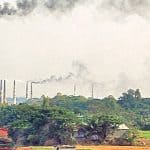The Char formed in the spring in almost all over the Surma River in Bangladesh has caused wailing!
By Zeba Tarannum

In Bangladesh, the winter is gone, and the spring season is going in nature, just like the song ‘the spring has arrived.’ In the pleasant environment of spring, the Cuckoos chirp, the old leaves fall off, and the new leaves grow, the tree is full of flowers, Various fruits grow.
When such form exists in nature just then, the longest Surma river in the country has started wailing. This miserable situation created as the Surma lost her strong current in spring and formed Char almost all over the Surma. The Surma lost its navigability in the spring and is no end to the people’s suffering on its Char.
Due to improper excavation work, the river’s bottom is filled, which led the whole river to be filled in the dry season. Similarly, due to the reduction of navigability in the rainy season, a little rain causes floods in the Surma river.
Due to loss of navigability, the river’s transportation has come to a complete halt this season. So, the farmers, traders, buyers, everybody has to pay extra for transporting goods in vehicles.
It has observed that at least 35 chars have been found in 32 km from Amalsid in Zakiganj, the source of Surma, to the junction of Lobachhara in Kanaighat Upazila.

Adjacent to Sylhet city, Kushighat, Kushituk, Srirampur, Kazirbazar, Mendibagh in the suburbs have become playgrounds in the riverbed. Soil is being sold irregularly from that field.
Water Development Board officials say at least 25-30 km of the river is in Bangladesh and India’s border area. However, the excavation initiative was attempted but impossible to implement as India did not give their consent. Then in 2018, initiatives have taken to excavate some chars of rivers in Sylhet Sadar and Bishwanath areas.
According to the Water Development Board, 110 km of about 249 km long Surma falls in Sylhet. In the last two decades, 40-45 per cent of these 110 kilometres have formed chars. Where the Char have bot formed there, the bottom of the river has been filled.
Visiting Kushighat, Kushituk area recently, it was seen that a huge char has risen on the river bank. The Surma has dried up and turned into a dead end. Wherever there is water, people are crossing the river on foot.

Somewhere the ferry is running, somewhere it’s can’t as the bottom of the river is filled, there is the place for the boatman’s oar. Children and teenagers are playing in the Char formed in the river.
Haji Abdul Alim, a resident of Kushituk, told the Media, ‘I have seen ships sailing through the Surma this season as well. Now the boat does not sail. Due to river filling, all the canals connected with the Surma have dried up.
Besides, the garbage of Kazirbazar of the city is falling on the Surma River. Chars in the dried-up river are waking up the garbage dumped by the local traders. And the four pillars of the Kazirbazar bridge at the heart of the Surma seem covered halfway across the river. As a result, the Char is forming by filling up behind the poles.
Surma River Gauge reader Abdul Karim Kim told the media that the Surma source had been closed for a long time. Due to this, water does not come to the Surma in the dry season. All the water goes to the Kushiyara river. The water that can be seen in the Surma during the dry season is the Lova river’s water.
That is why the Char is forming in the Surma.

Also, one of the reasons for forming Char is unplanned sand extraction, cutting down the hills, causing a lot of soil to fall down. The Surma is filling up as the river cannot hold that soil.
He said reports have already been made in various places. But there is no initiative to matching the Surma with its source Barak. Char excavation is required in the dry season. River excavation is not science-based.
Those who get the job of excavation somehow show the excavation and take the money. The Surma will get back its navigability only if the excavation is done in a planned manner.
Mohammad Shahiduzzaman Sarkar, the executive engineer of Water Development Board Sylhet, told the media that he had informed the higher authorities about the excavation of the Surma source in Barak Valley. This has also been discussed at the secretary level.
Earlier, in 1997, an initiative was taken to excavate the source of the Surma. Then some survey work is also done. But the initiative was not implemented without the consent of India.
Besides, the Executive Engineer of Bangladesh Inland Water Transport Authority (BIWTA) has taken the initiative to excavate 125 km from Kanai to Chhatak to increase Surma’s navigability. In order to prevent erosion, WDB is conducting work in the area of 850 meters in Sylhet Sadar Upazila and 800 meters up to Rajapur Pargana Bazar of Bishwanath.
In 2018, a proposal was sent from the Water Development Board’s Dhaka office to the ministry to excavate the awakened Char of the Surma in Sylhet and Bishwanath Upazilas.
The north-eastern border of Sylhet is the river Surma. It originates in the Barak estuary of Zakiganj on Bangladesh’s border through Karimganj in Assam and the Barak river in India. The two rivers flowing into Bangladesh from there are the Surma and the Kushiyara.
The 249 km long Surma flows over Sylhet city and Sunamganj, join the mouth of the Baulai river in the Sunamganj district. Navigability crisis occurs in winter in monsoon, prone to floods.



